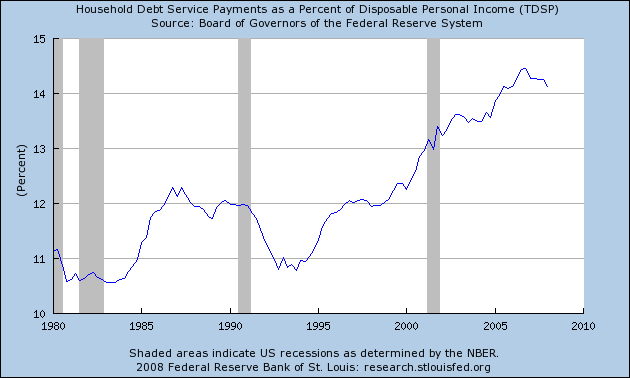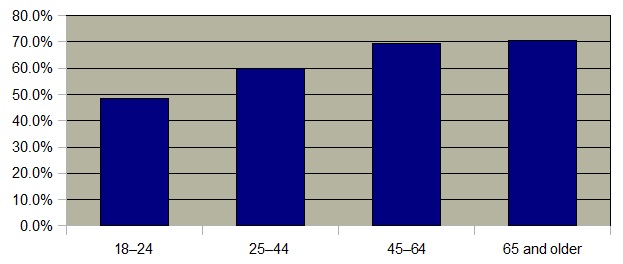– The Chart Of The Decade (ZeroHedge, Mar 27, 2012):
This chart tells millions of stories. I’m trying to get my head around its implications.
That’s right: since 1984 (surely an appropriate year) while the elderly have grown their wealth in nominal terms, the young are much worse off both in inflation-adjusted terms, as well as nominal terms (pretty hard to believe given that the money supply has expanded eightfold in the intervening years). So why are the elderly doing over fifty times better than the young when they were only doing ten times better before?
Are young people a stupefied generation coddled by parents and government, addicted to welfare, junk food, drugs and reality TV?
To some extent, but are they any less fiscally and morally responsible than the marijuana-smoking, free-love-embracing, national-debt-accruing baby boom generation? That’s a matter of opinion, but my answer is probably not. Baby boomers hate Ron Paul, while the under-35s seem to love him.
Is it due to government policies that favour the elderly and screw the young?
America is suffering from excessive consumer debt:
Net worth is calculated by subtracting debt from assets. The biggest debt for most people is a mortgage. So having more mortgage debt or less mortgage debt tends to be a pretty good determinant of net worth. (And no — unlike in the United Kingdom and Australia which have a severe problem with housing affordability — housing in the USA is still cheap today priced in wages)
The elderly have very often already paid off their mortgages — no doubt helped by the 1980s and 1990s where both stock prices and house prices grew rapidly. And why did rise so rapidly?
Some say that it came on the back of excessive expansion of the money supply beyond the economy’s productive capacity. But that doesn’t seem quite true:
The money supply grew in tandem with industrial production. This was no bubble, but organic growth (albeit as I have shown before on the back of cheap Chinese goods and cheap Arab energy).
My hypothesis is that the present situation is a product of government expansion.
Here’s government expenditure as a proportion of GDP:
Government spending in democracies very often tends to constitute a transfer of wealth from non-voters to voters (as well as groups that can’t afford lobbyists to groups that can afford lobbyists — perhaps that is one reason why corporate profits are soaring while youth unemployment remains elevated, and why Wall Street banks get bailed out, but delinquent small businesses do not).
Here’s the voter turnout by age in the 2004-2008 Presidential elections:
Older people vote in droves. Politicians want their votes and therefore promise them more free stuff — medicare, medicaid, services — and they vote for whoever offers them the most.
The biggest issue though, is this:
Keynesians may say that this reflects a government’s failure to create jobs for young people. They claim that the problem is that there is not enough money circulating in the economy, and that government can “raise demand” by pumping out more cash. But there is plenty of money in the economy; so much money that Apple have built up a $90 billion cash pile. So much that China has built up a $3 trillion cash pile. So much that banks are holding $1.6 trillion in excess reserves below fractional lending requirements.
More likely is the reality that overregulation and barriers to entry preventing the unemployed from picking up the slack in the jobs market. As John Stossel reveals in a recent documentary film, in New York City it costs $1 million to get a licence to drive a taxi. Anyone who wishes to operate a food cart, or run a lemonade stand has to traverse reams of bureaucracy, acquire health and safety certificates, and often pay huge fees to receive the “necessary” accreditation. While some barriers to entry are necessary (e.g. in medicine), in other fields it is just an unnecessary restraint on useful economic activity. In many American cities it is now illegal even to feed the homeless without government certification and approval. Citizens who defy these regulations face fines, arrest, and even imprisonment.
In a recent article, the Economist noted:
Two forces make American laws too complex. One is hubris. Many lawmakers seem to believe that they can lay down rules to govern every eventuality. Examples range from the merely annoying (eg, a proposed code for nurseries in Colorado that specifies how many crayons each box must contain) to the delusional (eg, the conceit of Dodd-Frank that you can anticipate and ban every nasty trick financiers will dream up in the future). Far from preventing abuses, complexity creates loopholes that the shrewd can abuse with impunity.
The other force that makes American laws complex is lobbying. The government’s drive to micromanage so many activities creates a huge incentive for interest groups to push for special favours. When a bill is hundreds of pages long, it is not hard for congressmen to slip in clauses that benefit their chums and campaign donors. The health-care bill included tons of favours for the pushy. Congress’s last, failed attempt to regulate greenhouse gases was even worse.
Complexity costs money. Sarbanes-Oxley, a law aimed at preventing Enron-style frauds, has made it so difficult to list shares on an American stockmarket that firms increasingly look elsewhere or stay private. America’s share of initial public offerings fell from 67% in 2002 (when Sarbox passed) to 16% last year, despite some benign tweaks to the law. A study for the Small Business Administration, a government body, found that regulations in general add $10,585 in costs per employee. It’s a wonder the jobless rate isn’t even higher than it is.
The truth may be that the inability of the unemployed to become self-employed is the force that is squeezing the jobless most. Certainly, job migration overseas has changed America, but why should it mean continued elevated unemployment? There is enough money to keep the economy flowing so long as there are opportunities for people to make themselves useful in a way that pays. With the crushing burden of overregulation and the problem of barriers to entry, these opportunities are often restricted to large corporations.
These issues of youth unemployment and growing inequality between the generations are critically important. Unemployed and poor swathes of youth have a habit of creating volatility in response to restricted economic opportunity.





